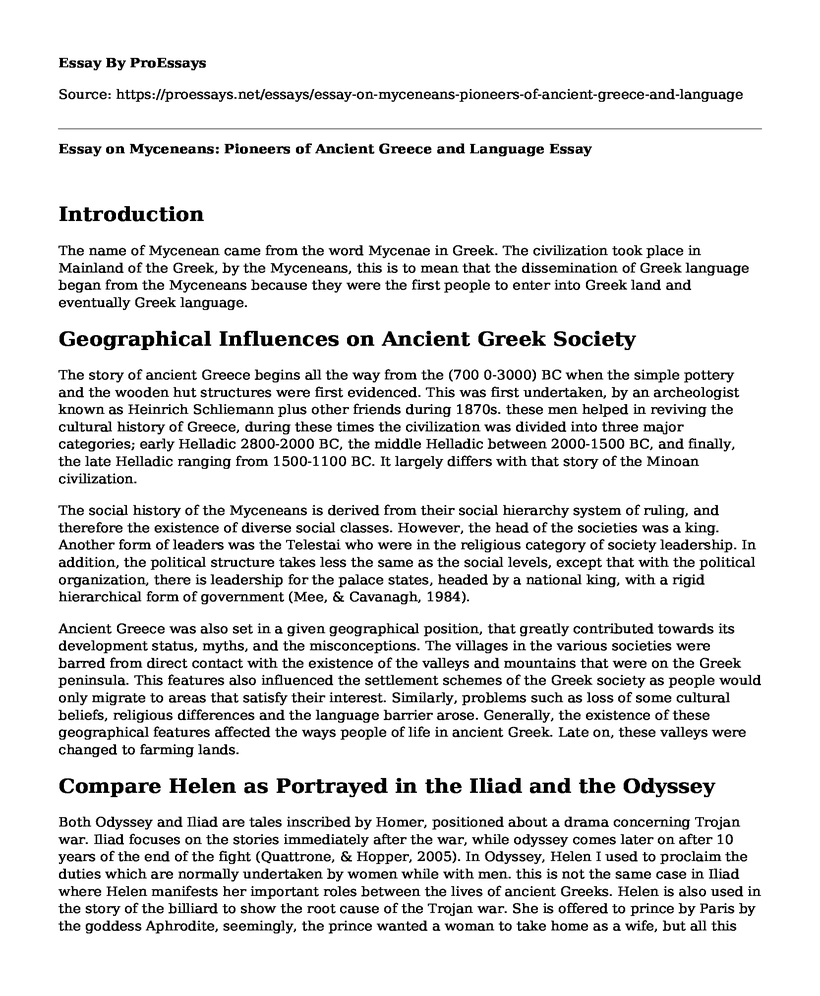Introduction
The name of Mycenean came from the word Mycenae in Greek. The civilization took place in Mainland of the Greek, by the Myceneans, this is to mean that the dissemination of Greek language began from the Myceneans because they were the first people to enter into Greek land and eventually Greek language.
Geographical Influences on Ancient Greek Society
The story of ancient Greece begins all the way from the (700 0-3000) BC when the simple pottery and the wooden hut structures were first evidenced. This was first undertaken, by an archeologist known as Heinrich Schliemann plus other friends during 1870s. these men helped in reviving the cultural history of Greece, during these times the civilization was divided into three major categories; early Helladic 2800-2000 BC, the middle Helladic between 2000-1500 BC, and finally, the late Helladic ranging from 1500-1100 BC. It largely differs with that story of the Minoan civilization.
The social history of the Myceneans is derived from their social hierarchy system of ruling, and therefore the existence of diverse social classes. However, the head of the societies was a king. Another form of leaders was the Telestai who were in the religious category of society leadership. In addition, the political structure takes less the same as the social levels, except that with the political organization, there is leadership for the palace states, headed by a national king, with a rigid hierarchical form of government (Mee, & Cavanagh, 1984).
Ancient Greece was also set in a given geographical position, that greatly contributed towards its development status, myths, and the misconceptions. The villages in the various societies were barred from direct contact with the existence of the valleys and mountains that were on the Greek peninsula. This features also influenced the settlement schemes of the Greek society as people would only migrate to areas that satisfy their interest. Similarly, problems such as loss of some cultural beliefs, religious differences and the language barrier arose. Generally, the existence of these geographical features affected the ways people of life in ancient Greek. Late on, these valleys were changed to farming lands.
Compare Helen as Portrayed in the Iliad and the Odyssey
Both Odyssey and Iliad are tales inscribed by Homer, positioned about a drama concerning Trojan war. Iliad focuses on the stories immediately after the war, while odyssey comes later on after 10 years of the end of the fight (Quattrone, & Hopper, 2005). In Odyssey, Helen I used to proclaim the duties which are normally undertaken by women while with men. this is not the same case in Iliad where Helen manifests her important roles between the lives of ancient Greeks. Helen is also used in the story of the billiard to show the root cause of the Trojan war. She is offered to prince by Paris by the goddess Aphrodite, seemingly, the prince wanted a woman to take home as a wife, but all this plan fails because Helen is already a wife to another king of Sparta called Menelaus. A marriage which is seen to have lasted for a comparatively longer time. The Trojan war finally begins when Prince Paris decided to leave with Helen unknowingly from the wedding, an issue which causes trojan war in seek of Helen (Quattrone, & Hopper, 2005).
However, in the Odyssey, Helen appears in the first meeting between Telemachos and Sparta. Helen is observed to be very jovial and trues to avoid chaos eruption during the dinner hours, a fact that could be possible to the style that Helen was using to the server he drinks. At the end of this story, she decides to get a nice clothe and hands it over to Telemachus so that she can wear it during the occasion of marriage.
References
Schoep, I. (2002). Social and Political Organization on Crete in the Proto-Palatial Period: The Case of Middle Minoan II Malia. Journal of Mediterranean Archaeology, 15(1).
Quattrone, P., & Hopper, T. (2005). A 'time-space odyssey': management control systems in two multinational organizations. Accounting, Organizations and Society, 30(7-8), 735-764.
Mee, C. B., & Cavanagh, W. G. (1984). MYCENAEAN TOMBS AS EVIDENCE FOR SOCIAL AND POLITICAL ORGANISATION. 1. Oxford Journal of Archaeology, 3(3), 45-64.
Peatfield, A. A. (1990). Minoan peak sanctuaries: history and society. na.
Cite this page
Essay on Myceneans: Pioneers of Ancient Greece and Language. (2023, Jan 02). Retrieved from https://proessays.net/essays/essay-on-myceneans-pioneers-of-ancient-greece-and-language
If you are the original author of this essay and no longer wish to have it published on the ProEssays website, please click below to request its removal:
- Compare and Contrast Essay on Two Kinds, Perfect Strangers, and Harrison Bergeron
- The Rise of Charlemagne Paper Example
- "Condemnation of the Duke" Is "The Least Interesting Response" in "My Last Duchess"
- Analysis of Dis Poetry by Benjamin Zephaniah Essay
- Pericles: Athenian Leader in War and Reconstruction - Essay Sample
- Gnosticism: A Unique Perspective in Ancient Greek Religion - Essay Sample
- Free Essay Example on The Roaring Twenties







